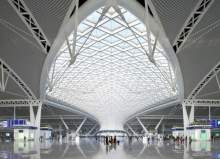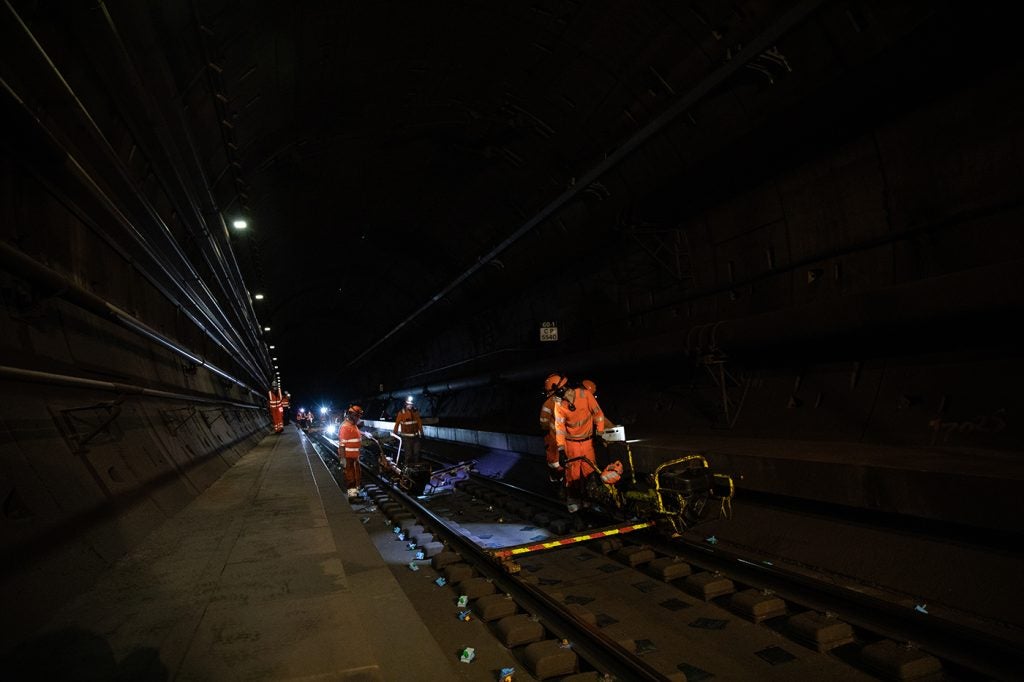
Many of the newly-built or refurbished stations of today already apply the concepts of tomorrow. Here, we catch up with some of the latest developments, from self-produced and sustainable energy supplies, revolutionary security concepts, e-ticketing and near-field communication to groundbreaking architectural designs which help improve passenger flows.
Green energy for railway stations
Even though electric rail travel is considered to be a rather sustainable form of public transport, railway stations usually have soaring energy demands and high carbon footprints. To make the necessary step into a greener future, UK operator National Rail has decided to install 4,400 solar panels on the roof of the revamped Blackfriars railway station in London.
Work on the £7.3m project started in October 2011 as part of a £5.5bn Thameslink project. The 6,000m2 of panels are expected to generate enough energy to meet half the electricity needs of the station and reduce annual CO2 emissions by an estimated 511t.
Built on the existing Victorian overpass spanning the River Thames, Blackfriars station will become the world’s largest solar bridge, once completed in 2012.
Network Rail project director for Blackfriars Lindsay Vamplew said in a statement in October that the refurbishment will make the station a template for green stations worldwide. “Constructed in the age of steam, we’re bringing it bang up to date with twenty-first century solar technology to create an iconic station for the city,” he said.
Other countries have also shown commitment to develop renewable energy for rail stations. China’s Shanghai Hongqiao railway station, for instance, went on the grid in July 2010 with a 6.7MW solar roof integrated into the building’s awnings. Currently the world’s biggest greenhouse gas emitter, the republic also plans to open the most energy-efficient public building in China, with the instalment of 7MW solar modules on the roof of Nanjing South railway station.
How well do you really know your competitors?
Access the most comprehensive Company Profiles on the market, powered by GlobalData. Save hours of research. Gain competitive edge.

Thank you!
Your download email will arrive shortly
Not ready to buy yet? Download a free sample
We are confident about the unique quality of our Company Profiles. However, we want you to make the most beneficial decision for your business, so we offer a free sample that you can download by submitting the below form
By GlobalDataFuture security
In the post-9/11 world, security is an absolute top priority, especially at major transport hubs. Given that rail networks carry as many, if not more, passengers as major airports but use only a fraction of the security measures, operators globally are working on new measures to beef-up security methods like access control, metal detection and even biometrics.
Although terrorism countermeasures will be the subject of ongoing research and investment for rail operators and governments, major effort is also being dedicated to protecting passengers and stations from more menial crimes like theft, assault and vandalism.
South West Trains in the UK, for example, has partnered with the British Transport Police to improve station security, implementing measures like improved CCTV, emergency help points and well-designed lighting systems across its network.
Technology companies are also coming up with bespoke solutions to specific security problems. For example, Bosch Security developed its Aegis UFLED white light illuminator in response to increased reports of station vandalism and cable theft.
This intelligent system can issue voice warnings to intruders, capture images and automatically send alerts to staff via text message and e-mail.
At night, the illuminator floods the area with light, allowing a full-colour picture to be taken. Integrating diverse camera, lighting and communications technology in this way could prove key to the security systems of the future.
E-ticketing and near-field communication
The way rail travellers purchase tickets is already in the process of a revolution, with paper-based ticketing slowly being set aside in favour of ticketless systems based on smart cards and contactless technology.
The ticketless concept now looks set to go a step further, with dedicated smart cards replaced by near-field communication (NFC) chips that can be placed inside credit cards and smartphones for fare payments.
Highly developed Asian countries like Japan and South Korea have been leading the world for years in the development of this technology. For these countries, making payments through phone chips is not a technology of the future, but of the present. In a recent Accenture survey, 69% of Asian respondents said they prefer to make payments using NFC-enabled phones, a significant leap over Europe and the US, where only 26% of those surveyed said the same.
In Japan, the market is dominated by comms company NTT, which launched its Osaifu-Keitai mobile platform in 2004. One of the earliest apps developed for compatible handset was Mobile Saifu, which allows rail travellers to pass through ticket barriers with the swipe of a smartphone.
With companies like German IT specialist Höft & Wessel developing NFC-enabled credit cards for rail access, however, the rest of the world might not have to wait too much longer to catch up with Asia.
Designs to impress
Railway stations are monuments to architectural design and style, and the stations of the future are no exception. Impressive and futuristic shapes combined with sustainable materials and enhanced passenger and transportation flow concepts make many of the new constructions revolutionary architectural and public transport models.
The recently opened $1.8bn station in Guangzhou, China, is one example of future railway stations with designs to impress. Opened in early October 2011, the construction is built to handle 300,000 passengers daily. Arrivals are handled on the ground floor while departures are dispatched from the first floor, with 28 platforms in total. In addition, the building is vertically divided to provide infrastructure for taxis, cars, buses and connections to the metropolitan subway, which is positioned underground.
Designed by London-based TFP Farrells, the station is in the running for a 2011 World Architecture Festival award in transportation.
The main spine is made up of a 348m long skylight and the angled and hybrid structural roof opens up a series of spacious atriums arranged over six floors to disperse the crowds in the building. According to the architects, the design has been inspired by contemporary airport designs.
The skylight becomes wider near the two main entrances and slimmer towards the centre. The adjacent barrel-vaulted structural steel grid entails air cushions to introduce daylight while minimising solar gain. The overall master plan also contains two large vegetated plazas at both opposing entrances, which are made of native trees and plants.
Asia’s virtual supermarkets
Online shopping is nothing new, especially in connected Asian countries like South Korea, Japan and China. However, the way forward is shopping online in public spaces such as subway and railway stations, while waiting for the next train. In South Korea, Homeplus, the country’s second largest supermarket chain owned 95% by British grocery giant Tesco, highlighted the potential for mobile proximity technologies to transform commuting and shopping.
The retailer opened its first virtual shop in August 2011 in a subway station in Seoul, followed by several others throughout the country. Using the layout of typical supermarkets but with images of products, each of them including a QR codes, commuters can browse the ‘aisles’ and choose from 500 of the most popular grocery products.
They can purchase them by taking a picture of the corresponding barcode and then checkout and pay from their phone. As long as their order is placed before 1pm, their items will be delivered that same evening.
Results of a trial run, conducted between November 2010 and January 2011, saw the number of newly registered online shoppers increase by 76%, while sales for the retailer increased by 130%. The concept has now also been picked up in China, where the country’s leading online grocery story Yihaodian has opened virtual supermarkets in 11 Shanghai metro stations so far, combining busy commuting with everyday essentials.
Movable platforms: fact or science fiction?
Perhaps the most outlandish future rail station concept to have been introduced recently has come from UK design firm Priestmangoode.
With the arrival of high-speed rail, modern trains can carry passengers faster than ever before. But Priestmangoode believes that to take full advantage of these new trains, something must be done to improve the infrastructure on which it runs.
After all, the basic formula of stopping at a station, picking up passengers at the platform and pulling away has been the same since the age of the steam train.
What if instead of the train stopping at the platform, the platform could come to the train? This is what Priestmangoode’s new design concept, Moving Platforms, asks. Under the new concept, stations would do away with platforms completely, replacing them with local connecting trams, which could pull alongside approaching trains, allowing passengers to move on and off the train without ever stopping. An added benefit, the company says, would be that travellers would potentially be able to make a door-to-door journey, via local trams and high-speed trains, without ever getting off a train.
It’s a concept that seems to border on science fiction and it would certainly require an incredible amount of investment to completely re-sculpt the way we interact with our rail networks. It’s something that Priestmangoode director Paul Priestman recognises. “I’m under no illusion this is a big idea, but we have to think big,” he said.
“The world is going to be a very different place in 10 to 20 years and we have to think of alternative ways to travel.”
By Elisabeth Fischer and Chris Lo





